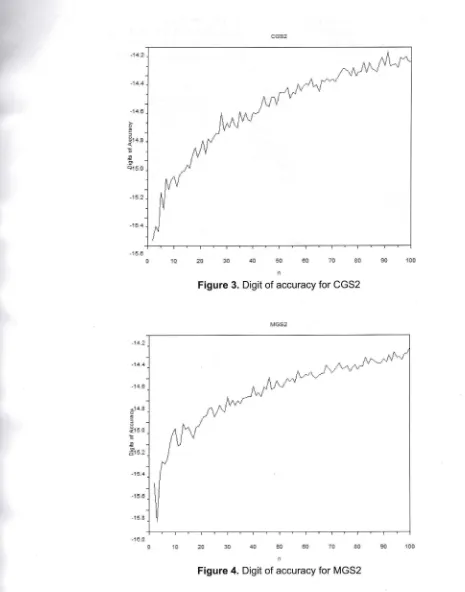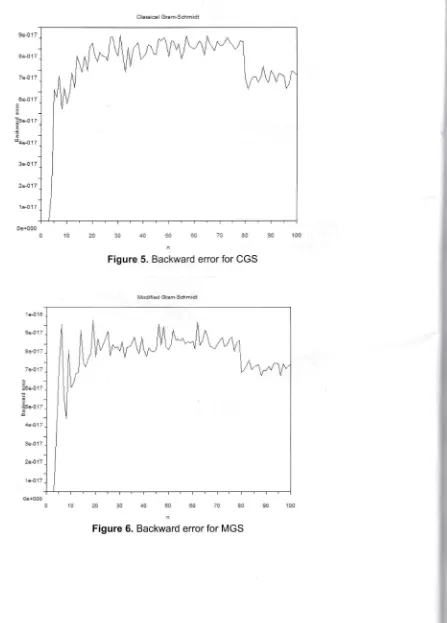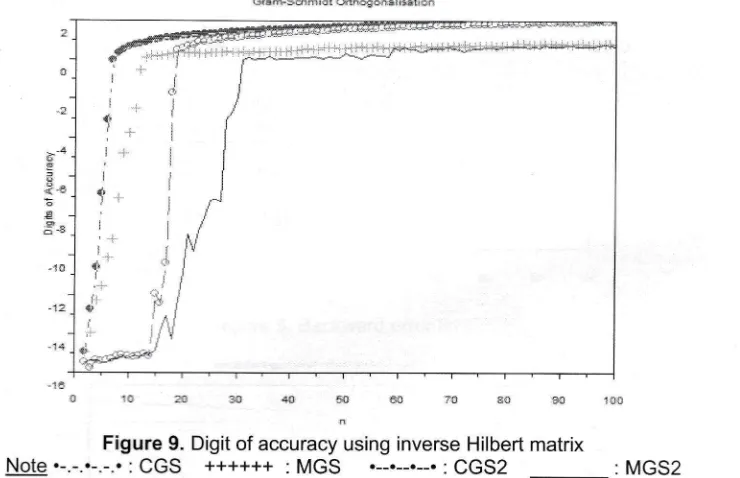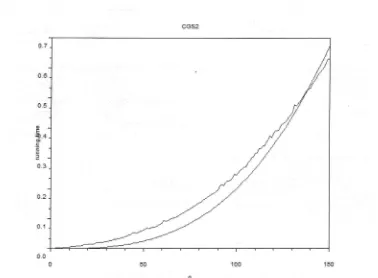Vol.
12, No. 2,
Juli
2009
srMULAsr
srsrEM
DTNAMTKuNruK
r.^fi-tl"Y'il$'*,,-o,
DEGRADA.T KESEHATAN AKTBATPOLUSIGAS SOX DI UDARAAMBIEN DKIJAKARTA
Sudi Mungkasiand Lusia Krismiyati Budiasih
EXPERIMENTS ON GRAM.SCHMIDT PROCESS AND GRAM.SCHMIDT PROCESS
W]TH REORTHOGONALISATION
Jose Rizal, Sutawanir Darwis dan AliAshat
APLIKASI SIMULASI ANNEALING DALAM MEMPREDIKSI
TEKANAN ALIR RESERVOIR PANAS BUMI
M. Masykuri, Cynthia L. Radiman, I Made Arcana dan Sadijah Achmad
PENGARUH JENIS DIOL DAN PEMANJANG RANTAITERHADAP
vrsKosrTAs
TNTRTNSTK PoLr(u RETAN-U REA)Paul Suparno
DIFRAKSI SINAR X UNTUK MENGUKUR JARAK DIFRAKSI KRISTAL MgO, LiF, DAN NaF
Halauddin dan Suhendra
APLIKASIAUTOMATA GAS KISI UNTUK MENGESTIMASI
PERMEABILITAS RETAKAN BATUAN
Hanggara Sudrajat, Maria Eka Putri, dan Bambang Soediharjo
ANTIM ICROBIAL E FFECTS OF RH IZOPHORA APICULATA PYROLIG N EOUS
ACID AGAINST PATHOGENIC MICROORGANISMS
Nurul Sumiasri, Yani Cahyani, dan Dody Priadi
PENGARUH BERBAGAI MEDIA DAN WAKTU PERENDAMAN BIJITERHADAP
PERTUMBUHAN BIJIJARAK PAGAR (Jatropha curcas L)
Linggo Sumarno, Adhi Susanto, Thomas SriWidodo dan Jazi Eko lstiyanto
SEGMENTASI KATA TULISAN TANGAN MENGGUNAKAN TAPIS GAUSSIAN 1D
Flora Elvistia Firdaus
PENGARUH KONDISI OPERASI PROSES HIDROLISISJAGUNG MANIS (Zea Mays Saccharata) TERHADAP KANDUNGAN GLUKOSA
1410 - 5888
RNAL SAINS DAN
TEKNOLOGI
Jurnal sains dan teknologi SIGMA diterbitkan dua kali setahun, yaitu pada bulan Januari
dan Juli, sebagai wahana komunikasi ilmiah
di
bidang sains dan teknologi serta lintas-ilmu yang terkait. Penyunting menerima karangan ilmiah dalam bidang-bidangte[ebut
berupa hasilpenelitian, survai, atau telaah pustaka, yang belum pernah dipublikasikin dalam terbitan lain,
Penyunting berhak untuk menyunting karangan yang akan dimuat tanpa mengubah isinya.
Ke-tentuan tentang penulisan karangan dapat dibaca pada bagian dalam sampul belakang jurnal in i atau d i http :/www. usd.ac. id/06/j urnal/sigma. htm.
DEWAN PENYUNTING
Pemimpin / Penanggungjawab
Wakil Pemimpin / Wakil Penanggungjawab
Sekretaris
Dewan Penyunting
Penyunting Pelaksana
Sekretaris Ad m i n istrasi
Prof. Dr. Frans Susilo, SJ
lr. Greg Harjanto
Dr. C.J. Soegihardjo, Apt
Prof. Drs. R. Soemantri lr. Bambang Sutopo, M.Phil Drs. J. Eka Priyatma, M.Sc lr. lg. Aris Dwiatmoko, M.Sc
Dr. lgn. Edi Santosa, M.Si
lr. F. A. Rusdi Sambada, M.T
Y
Kristio Budiasmoro, S.Si, M.SiAgnes Maria Polina, S.Kom, M.Sc
Y.G. Hartono, S.Si, M.Sc
A. Yunaeni Mariati, S.E
Alamat Penyunting:
Fakultas Sains dan Teknologi Universitas Sanata Dharma Kampus lll: Paingan, Maguwoharjo, Depok, Sleman.
Teromol Pos 29, Yogyakarta 55002
Telpon: (0274) 883968,883037. Fax. (0274) 886529
E-mail: sigma@staff. usd.ac. id
Penerbit:
Lembaga Penelitian dan pengabdian Kepada Masyarakat (LppM)
Universitas Sanata Dharma Kampus ll: Jl. Affandi, Mrican Teromol Pos 29, Yogyakarta 55002
SIGMA
JURNAL SAINS
DAN
TEKNOLOGI
Vol. 12, No.
2
Juli 2009 ISSN: 1410-5BBBDAFTAR
ISI
EIXTORIAL
iiiSITULASI SISTEM DINAMIK UNTUK MEMPREDIKSI NILAI DEGRADASI
KESEHATAN AKIBAT POLUSI GAS SOX DI UDARA AMBIEN DKIJAKARTA
Sri
Listyarini...
...
103 -1'15EXPERIMENTS ON GRAM.SCHMIDT PROCESS AND GRAM€CHMIDT PROCESS
wlTH REORTHOGONALISATION
SudiMungkasiand Lusia Krismiyati
Budiasih...
..
117 -126APLIKASI SIHUI.ASI ANNEALING DALAM MEMPREDIKSI TEKANAN ALIR
RESERVOIR PANAS BUMI
Jose Nzal, Sutawanir Darwis, dan Ali
Ashat
...
127 -136PENGARUH JENIS DIOL DAN PEMANJANG RANTAI TERHADAP VISKOSITAS INTR|NStK POLI(URETAN-UREA)
M. Masykuri, Cynthia L. Radiman, I Made Arcana, dan Sadijah
Achmad...-
137 -144DIFRAKSI SINAR X UNTUK MENGUKUR JARAK DIFRAKSI KRISTAL MgO, LiF, DAN NaF
Paul
5uparno...,.
-.
145 -151APLIKASI AUTOMATA GAS KISI UNTUK MENGESTIMASI PERMEABILITAS RETAKI\N BATUAN
Halauddin dan
Suhendra
153 -160ANTIMICROBIAL EFFECTS OF RHIZOPHORA APICULATA PYROLIGNEOUS
ACID AGAINST PATHOGENIC MICROORGANISMS
Hanggara Sudrajat, Maria Eka Putri, dan Bambang
Soediharjo..
't61 -168PENGARUH BERBAGAIMEDIA DAN WAKTU PERENDAMAN BIJI TERHADAP
PERTUMBUHAN BIJIJARAK PAGAR (Jatropha curcas L)
Nurul Sumiasri, Yani Cahyani, dan Dody
Priadi...
169 -177SEGMENTASI KATA TULISAN TANGAN MENGGUNAKAN TAPIS GAUSSIAN 1D
Linggo Sumarno, Adhi Susanto, Thomas Sri Widodo, dan Jazi Eko
lstiyanto
179 - 1BgPENGARUH KONDISIOPERASI PROSES HIDROLISIS JAGUNG MANTS (Zea Mays Saccharata) TERHADAP KANDUNGAN GLUKOSA
Flom Etuistia
Firdaus
...
191 - 196SIGMA, Yol.12, No. 2, Juli 2009: 117-126
ISSN: 14'10-5888
EXPERIMENTS ON
GRAM.SCHMIDT
PROCESS
AND
GRAM.SCHMIDT
PROCESS
WITH REORTHOGONALISATION
Sudi Mungkasi and Lusia
Krismiyati
Budiasih
Department of Mathematics, Science and Technology Faculty, Sanata Dharma University,
Mrican, Tromol Pos 29, Yogyakafta 55002. E-mail address.' [email protected]
Abstract
This paper discusses the orthogonalisation process
in
Gram-Schmidt algo-rithms. Four variants of Gram-Schmidt process are presented, and the relation be-tween matrix size and running time for computation ls a/so discussed. Loss ofor-thogonality of the computed vectors in Gram-Schmidt process can be reduced to
be
close to the machine precision level by reorthogonalisation. Theoretically, the/oss of orthogonality
is
bounded, andit is
true that reorthogonalisationin
Gram-Schmidt process works well when the computation is not overflow. However, when reorthogonalisation is applied, the backward enor is becoming larger.Keywordst
Gram-Schmidt orthogonalisation, QR factorisation, backward error1.
lntroductionLet
A=(ar,K,ar)
bea
realrnxn
matrix(m>n
)
withfull
column rank. TheGram-Schmidt orthogonalisation process (Hogben, 2007: 5-8, 5-9) produces
an
orthogonal basisQ=(q,,K,q,)
of span(A)suchthatA=QR,whereRisan
nxn
uppertriangularmatrix.Throughout the paper, unless stated explicitly as in the attachment, ll A
ll
denotes the norm of matrixA,
r(A)
refers the condition number of the matrix, andllx
ll
denotes theEuclid-ean norm of vector
x.
The unit roundoff is denoted by u. The terms cn(m,n) are low degree polynomials in the problem dimensions m and n, where k is nonnegative integer; they are inde-pendent of the condition numberr(A)
and the unit roundoff u, but they depend on details of the computer arithmetic.There are several variants of the algorithms for Gram-Schmidt orthogonalisation. The first is Classical Gram-Schmidt (CGS) which is known to be unstable, and the second is Modified Gram-Schmidt (MGS) which is a stable algorithm (Trefethen & Bau, 1997:48-61). Bjdrck (1967)
shows that although CGS and MGS are mathematically equivalent, due to round-off errors the
set of vectors prcduced by either of these two methods can be sometimes far from orthogonal.
ln general, the loss of orthogonality of vectors computed by the CGS process is faster than the loss of that of vectors computed by the MGS (Giraud et a1.,2003).
To improve the orthogonality of the vectors computed by Gram-Schmidt process,
reor-thogonalisation can be applied. Reorreor-thogonalisation here means the orreor-thogonalisation step is
iterated twice or several times. ln some applications it may be important to generate a set of
basis vectors which its orthogonality is on the level of the machine precision. Hoffmann (1989) conjectures that two steps of reorthogonalisation are enough for obtaining orthogonality which is
close to the machine precision. Then, Giraud et al. (2005) represent the theoretical foundation
for this observation. For convenience in this paper, Classical Gram-Schmidt with
reorthogonali-sation and Modified Gram-Schmidt with reorthogonalisation are denoted by CGS2 and MGS2 respectively.
The organisation of this paper is as follows. Section
2
givesa
brief overviewof
howGram-Schmidt process works and then discusses the loss of orthogonality of the vectors be.
cause of rounding error in the calculation. The discussion is divided into two parts, the first part
represents the theoretical background in rounding error in the discussed algorithms, and the
second part presents result for application of the algorithm for several types of matrices. Section
3
containsthe
relation between matrix size and running timefor
orthogonalisation. SubseSudi Mungkasi and Lusia Krismiyati Budiasih
quently, section 4 concludes the discussion. Several Scilab codes used in the work of ihis paper are attached.
2.
Loss of Orthogonality in CGSHow CGS and its r6orthogonalisation work are described in this section
(reorthogonalisa-tion in MGS can be done in an analogous way). This section also gives an overview of the
the-ory
relatedto
Gram-Schmidt orthogonalisation, and presentsthe
outputof
four variants in Giam-Schmidt orthogonalisation when they are being implemented in Scilab-4.1'1.Giraud et at. (ZOOSI represent details and thorough analysis of the CGS and CGS2 ver-sion. ln both algorithm, CGS and CGS2, the matrixwith orthonormal column
Q=(9r,K,q,)
isassumed
to be
constructed column-by-eolumnso
that
for
each
index
i
= 1,K ,nspan (q,,K,Q;)
=
span(a.,,K,a7). The CGS
algorithm startswith
q',:a,/lla,ll
and
forj
=2,t<,n
it successively producesv,
=[l-Q,
,QrI,,la,where
ji
= ail
ll a; ll . The corresponding columnr,
in the upper triangular factor R:
(r,,K ,r, )is given as
rj
:1af
,ai,llv,
ll)'.
In CGS2, the vectors are computed as follows. Starts from Qr:
?r/ ll a,rll,
and forj :2,K,n
tvvo vectorsv,
andwj
are computed successively(1)
v,
=[l_ei_ref
,]a,
w,
=[!-
Q, ,QrIllv;
Normalising
w,
will gete;,
"6
9r:wil1|w, ll.
The conesponding cdumnr,
in
the triangular factor is given asr,
:
(r;-1,0)r +sj
= (Qf-1a;,0)r+(Qf'-1v;,llw;
lDrwhere
!
r:
Qf ,ar,and
s,
:
(Qf-rv;,;;w,
ll)'-Thorough analysis of the MGS version is not presented in this paper However, the algorithm
and some output of both MGS and MGS2 will be discussed.
2.1. Rounding Error in CGS
According
to
Giraudet
al.
(2005),the
lossof
orthogonalityfor
CGS and CGS2 are bounded as stated in the two theorems below.Theorem
I
Assuming cr(m,n)urc2(A)<1, the loss of orthogonality of the vector
Q
computed by the CGS algorithm is bounded bylll-
OrO,r''
c'(m'n)u12(!)
1
cr(m, n)u 121e)where c.(m,n) = O(mn2) .
Theorem 2
Assuming co(m,n)ur(A)< 1 , the loss of orthogonality of the vectors Q
algorithm can bounded as
ll I
-
OrO fl< cr(m,n)u where co(m,n) -O(m2n31 and cu(m, n) :O(mn3t2) .From the two theorems above, the CGS2 seems more accurate in terms of orthogonality
than CGS. ln their paper, they illustrate theirtheoretical results using
a
200x100 matrices Angenerated by computing
A.
= UEkVr , where U and V are randomly chosen orthonormalmatri-(.2)
(3)
upper
(4)
computed by the CGS2
(6)
118 SIGMA Vol. 12, No. 2, Juli 2009
ln terms of the orthogonality of matrix Q, MGS has a better result than CGS; but in fact, in
sev-eral cases the orthogonality is still not a satisfactory. ln so called an orthogonal basis problem
which requires the individual column vectors of Q matrix, preserving the orthogonality of the col-umn vectors in Q matrix is becoming an important issue (Hoffmann, 19Bg). More details of CGS and MGS can be found in Trefethen & Bau (1997: 48-61).
Giraud et al. (2003) have proved that one reorthogonalisation step is enough for preserv-ing the orthogonality of computed vectors close to machine precision level. Reorthogonalisation means each orthogonalisation step is performed exactly twice. Note that it is different from CGS
which is performed twice. Therefore, CGS2 and MGS2 algorithms can be written as follows. Experiments on Gram-Schmidt Process and Gram-Schmidt Process with Reorthogonalisation
ces and En , diagonal matrix, contains the singular values of An uniformly distributed between 1
and 10-k for k =1,K,8 .
The CGS and MGS algorithms can be written as follows. CGS:
for 1=1 'n'
V(:,j)=A(:,j);
for i=1:j-1;
R(i j)=Q(:'i)'-A(:'j); V(:,i)=Y1',i1-R(i,i).Q(:,i); end; R(j,j)=norm(v(:,j)); a(:,j)=V(:,j)/R(,j); end; MGS:
for j-1 :n; V(:,j)=A(:,j);
for i=1:j-1;
R(i'j)=q1''
iY.'t''','
V(:'i)=Y1''1;-R(i'i).Q(:'i); end; R(j,j)=norm(V(:,j)) Q(:,j)=V(:,j)/Rfi,j) end; CGS2:for 1='1'n' V(:,j)=A(:,j); for i='l:j-1; R(i,j)=q1',;1*o,',',' v(:,i)=Y1',1;-R(i,i).Q(:,i); end; W(:,j)=V(:j); for i=1:j-1;
R(i'j)=q1'';Y-'t'
'''
W(:'i)=W(:'i)-R(i'i).Q(:' i);end;
R(j,j)=norm(w(:,j));
Q(:,j)=W(:,j)/R0,j);
end;
2.2. Simulation Result
lmplementing those four algorithms in Scilab-4.1.1 using 2x2,K,'100x100 random
ma-t.ces where all the entries are uniformly distributed in the interval
(0,1)
as the test matrices generates output as shown in Figure 1 to Figure 4 as follows, where the digit of accuracy is cal-culated using the formula'otos ll
l-
QrQll
(7)and the norm is the infinity norm. Since the machine precision is about 10 16, the ideal case is that the digit accuracy is -16, which means QrQ = I .
MG52:
for j=1 :n; V(:,j)=A(:,j);
for i=1:j-1;
R(i'j)=q1''
;1'.',''','
V(:'i)=V('i)-R(i'i).Q(:'i);
end;
W(:,j)=V(:,j);
for i=1:j-1;
R(i'j)=q1'' i1'.W(:'j);
w(:,i)=w(:,i)-R(i,i)"Q(:,i);
end;
R(,j)=norm(W(:,j))
a(:,j)=W(:,j)/R(1,j)
end
Sudi Mungkasi and Lusia Krismiyati Budiasih
l: :a :: :: ::
Figure 1. D git of accuracy for CGS
' :: '=: :-'3- ,i=a-ir:
r; ;1 fl ai
--a
Figure 2. Digit of accuracy for MGS .3
.,.*
Experiments on Gram-Schmidt Process and Gram-Schmidt Process with Reorthogonalisation
S
,"18
;
:* 3a! 1' a.c ,,1 7, sl
E
Figure 3. Digit of accuracy for CGS2
iiG€:
-=aa- ?
1i :: :.1 r: at t, :: 1:
a
Figure 4. Digit of accuracy for MGS2
Digit of accuracy describes the level of orthogonality. Figure '1 to Figure 4 show that the level of orthogonality for CGS remains in the range between machine precision and 10-8, and
thatfor MGS remains between machine precision and 10-';while the level of orthogonality.for CGS2 and MGS2 remain in the same range, that is between machine precision and 10-'"'. Therefore, reorthogonalisation in CGS and MGS is worthwhile to keep the orthogonality of the computed vectors in matrix Q to be close to the machine precision. In other words, the
theoreti-cal proof of this, which is presented in Giraud et al. (2005), is matching with the obtained result.
Sudi Mungkasi and Lusia Krismiyati Budiasih
After finding the expected result in terms of orthogonality, the discussion will be continued
to investigate the backward error of the related factorisation. The backward enor here is
com-puted using formula
llA-aRll/llAll.
The norm used in this simulation is the infinity norm.Here the logarithmic scale is not used because for n = 2, CGS and MGS give ll A
-
aR
lF 0 .itasiel l?3r-!E:r*ia:
*
I'
74.e33{,a5050?g&1:Il
Figure 5- Backward enorfor CGS
k41A
Hl7
&e{r?
7e4'17
=
Se+{7 E
H{7
6
4=*17
r=s1?
k{t?
:i :.5 tl: nl ai ai :1
Figure 6. Backward error for MGS
Experiments on Gram-Schmidt Process and Gram-Schmidt Process with Reorthogonalisation
t.s
i E
s?t
* *F]
'ti 1* 4! .13 ai :i *,
a
Figure 7. Backward error for CGS2
i**difiEi a?_sr-t*niCi !i1i =.e**4EsrEli;Eii.F
*18?5lg14S*gI7S€*SSt**
*
Figure 8. Backward error for MGS2
By implementing the same test matrices as those are used before, the backward error are
shown in Figure 5 to Figure B. The backward errors in CGS and MGS are very small, and they are even smallerthan the machine precision. These errors lie between 0 and 10-'o. ln contrast,
the backward errors produced by CGS2 and MGS2 range between 0.65 and 1. These errors are
large enough, and
it
means thatthe
resulted factorisation using reorthogonalisationalgo-rithms,
A:
QR , is not so accurate.:l'{,_El : E : :-^-,1r,.'_ Er 1r_ --.ll
;?,i_-.r.Ba
&
Sudi Mungkasi and Lusia Krismiyati Budiasih
Therefore, the application of reorthogonalisation has advantages and disadvantages. On
one hand, the process without reorthogonalisation will be faster and the backward error is very small, but the orthogonality may be absent. On the other hand, the process with
reorthogonali-sation will be slower and the backward error is large enough, but the orthogonality of the com-puted vectors can be preserved close to the machine precision level.
An interesting result can be found by applying the same algorithms to either Hilbert matrix
or inverse of Hilbert matrix. ln this paper, only the inverse of Hilbert matrices are used as the
second set of test matrices (the result for Hilbert matrices is almost the same as the result for their inverses). Orthogonalisation
and
reorthogonalisation in Gram-Schmidt process can not beapplied
for
big-sizeH;],
inverse Hilbert matrix.When
n xn
inverse Hilbert matrix, forn
:2,K,100
is taken as the test matrix, the result is presented in Figure 9.;-S
-i{
Figure 9- Digit of accuracy using inverse Hilbert matrix
Note.___-._._..:
CGS
++++++ :MGS
:CGS2
: MGS2This result can be considered as one limitation of Gram-Schmidt orthogonalisation and its
reorthogonalisation. This failure of orthogonalisation and its reorthogonalisation might be
be-cause the computation in the orthogonalisation of the vectors
is
overflow,or
exceeding therange of number that scilab can take in to account. This prediction can be double checked by
multiplying
H;],
inverse Hilbert matrix and Hn,, Hilbert matrix for some large n, and in fact, the result is not an identity matrix.3.
Running Time for Calculating the VectorsThis section is also divided into two parts. The first part gives an overview of the theoreti-cal result of the operation count for Gram-Schmidt process, and the second part presents the relation between matrix size and running computation for CGS2.
3.1. Theoretical Background
Given
A,,,
matrix, the operation count for the CGSor
MGS algorithmis
2mn2 flops (Trefethen & Bau, 1997: 59), while that for CGS2 or MGS2 is 4mn2, twice as much as CGS or MGS because of the reorthogonalisation operation. Therefore, if the matrix size isnxn,
therunning time for those processes, f, will agree with the relation t
:
cn3 , where c is some con-stant.1r,
L:.s*Sal*1 idi 58t :B++*1 ilsi!*+
'+
: lr
+
14.
I
+,
,+t,
Cr
I
,11
I
A
/
3
i/\
SIGMA Vol. 12, No. 2, Juli 2009
Experiments on Gram-Schmidt Process and Gram-Schmidt Process with Reorthogonalisation
a
Figure 10. Relation between matrix size and running time
3.2. Simulation Result
ln this part, a set of more number of random matrices is used. The set of test matrices
which is used is
2x2,K,150x150
random matrices, where all the entries are uniformly distrib-uted in the interval (0,1). Here, recorded running time for calculating vectors is presented inFig-ure 10, and only the result for CGS2 is presented because the result for MGS2 is not much
dif-ferent, and so are the CGS and MGS. The unsmooth solid line is the relation between matrix
size and the running computation in Scilab. The smooth solid line is
y:2x1O-7
x3.
From thisresult, the relation between matrix size and the running time is approximately approaching the relation t
:
cn3 , wherec
is some constant, though c = 2x10-7is
not the best choice in this case.4. Gonclusion
Reorthogonalisation in Gram-Schmidt process is worthwhile to preserve the orthogonality
of the computed vectors close to the machine precision level. Reorthogonalisation does not
work, if the computation in the machine is overflow. However, applying the reorthogonalisation leads to a higher backward error. To choose which algorithm is appropriate to be applied in a
particular problem, considering the real problem is needed. That is if the problem is focusing
more on the orthogonality, Gram-Schmidt algorithms with reorthogonalisation will be more ap-propriate.
Acknowledgment
The authors would like to thank Dr. Linda Stals (Australian National University) and lwan Binanto, S.Si., M.Cs. (Sanata Dharma University) forthe fruitful discussions.
E
Sudi Mungkasi and Lusia Krismiyati Budiasih
Bibtiography
Bjorck'
A'
tgoz'
"solving Linear Least squares Problemsby Gram-schmidt orthogonalisation.,,
BlT,
7:1-21.Bj6rck'
A'
tggz'
"Loss-and Recapture of-orthogonality in theModified Gram-schmidt
Algo-rithm." S\AM J. Matrix Anat.
Appt.,1i
tt'l:
i}_ig6
ciarlet'
P' G'
1989' tntroductionto
Numerical Linear Algebraand optimisation. cambridge: Cambridge University press.
cullen'
c'
G' 1994' An tntroduction to Numeical Linear Algebra. Boston:pws
publishingcom-pany.
Giraud' L' and. Langou, J- 2002- "when Modified Gram-schmidt Generates a well-conditioned
set of vectors." rMA Journat of Numericar Anartysii,ii
(il,
s21_s28.Giraud'
L'
et at' 2003'"on
the Loss of orthogonality in the Gram-schmidt orthogonalizationProcess.,, CERFA CS Te c h n i ca t Re p o
rt
N7.f
ntpetO StZ S.Giraud' L' et al' 2005.'."Rounding Error Analysis of the classical Gram-schmidt
orthogonatiza-tion process;, Numer. Uain.,101: g7_100
Heath'
M'T'
2002' scientific computing: An tntroductory survey.New york McGraw-Hi1. Hogben, L- 2007. Handbook of Linear Atgebra. Boca Raton: chapman & Hail/cRC.
Kelley'
c'
T' 1998' tterative Methods for Linear and NontinearEquations.philadelphia: slAM.
Noble, B., Danier, J.w - 1977. Appried Linear Argebra. Engrewood criffs: prentice_Ha1.
*'"",
,CrE. 1966. "Experiments on Gram-schmidt orthogonarization.,
Math.comp.,20:
J2s_Trefethen, L. N. and Bau, D. ilr. 1gg7. Numericar Linear Argebra. phiraderphia: srAM.
SUDI MUNGKASI
Graduated from Gadjah Mada University
s1
Mathematics study programin
2oo4 and from the Australian Nationai University with Master or uratnematical sciences (M.Math.sc.)
de-ffi;:,.
"r,ff;
j3,,iu*
the Mathematicl Department of sanataDhrrr"
U;irilil
;
a facuttyLUSIA KRISMIYATI BUDIASIH
Graduated from satya wacana christian University
s1
Mathematics study programin
1999 and from Bandung lnstitute of rechnology.with rrrrigistei sains (M.si) degree in
2005.





